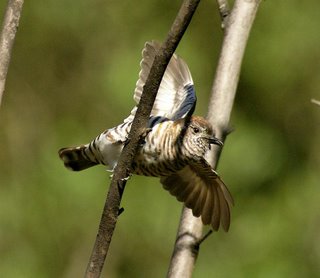 Ever since I made an error in a recent blog (I unwittingly substituted a shot of a Horsfield's Bronze-Cuckoo with a Shining Bronze-Cuckoo--it was a better image), I've been "chasing" these Cuckoos. While reviewing the shots, I realised that they're a little more difficult to distinguish than I previously believed. That is to say, the field marks that I have been using, aren't quite as definitive as I thought. Let me just say at this point, that I've relied heavily on calls, and with such a cryptically marked bird, that is often the first ( and sometimes the only) inkling that they are about. Pictured here are some shots taken in the Wielangta Forest of Shining Bronze-Cuckoos.
Ever since I made an error in a recent blog (I unwittingly substituted a shot of a Horsfield's Bronze-Cuckoo with a Shining Bronze-Cuckoo--it was a better image), I've been "chasing" these Cuckoos. While reviewing the shots, I realised that they're a little more difficult to distinguish than I previously believed. That is to say, the field marks that I have been using, aren't quite as definitive as I thought. Let me just say at this point, that I've relied heavily on calls, and with such a cryptically marked bird, that is often the first ( and sometimes the only) inkling that they are about. Pictured here are some shots taken in the Wielangta Forest of Shining Bronze-Cuckoos.I suppose because they are so cryptically marked, we generally see the odd bird, but while photographing them, I realised that they often, usually?, travel round in pairs. I guess that I shouldn't be too surprised at that. I noted them displaying too, which I also had not witnessed before. The shot at left shows a 'shining' apparently about to fly, but in reality, it's displaying its'
 wings at another 'shining'. It does a sort of slow flap, showing off the bronze sheen of its' wings.
wings at another 'shining'. It does a sort of slow flap, showing off the bronze sheen of its' wings.Often when calling, I note
 d this would trigger the arrival of Tasmanian Thornbills. They would often scold, as in the photograph at bottom and even chase off the calling bird. As a "host" to this cuckoo, I can only assume they recognise the potential threat, but
d this would trigger the arrival of Tasmanian Thornbills. They would often scold, as in the photograph at bottom and even chase off the calling bird. As a "host" to this cuckoo, I can only assume they recognise the potential threat, but  that may be jumping to conclusions.
that may be jumping to conclusions.I'm hoping to next get images of "Horsfield's", but so far, I think the 'Shining" outnumber them by a big margin.
2 comments:
Some lovely shots of the cuckoos, Alan, especially of the one displaying. We, too, generally find them hard to locate, and rely heavily on calls for recording their presence. So, too, for the Pallid and Fantailed Cuckoos, though they are a little easier to track down. The 'ventriloqual' nature of cuckoos' calls doesn't help, either. The call often SEEMS to be coming from quite a different place to where the bird actually is.
Shining bronze mostly sound very like someone whistling a dog, with short, rising, quickly repeated 'fwee-fwee-fwee'. The Horsfield's, on the other hand has a slower, descending but farily piercing 'tyiooo.....tyiooo....' etc. The confusing bit is that the Shining also SOMETIMES has a descending whistle like the Horsefields', only not as high or strident. It genereally gives this descending call in association with the 'dog-whistle' type, though so it's usually not too confusing between them. Also, as Alan has rightly noted, the Shining is by far the more common in Tassie.
People could come along to the 'Bird Calls' outing for Birds-Tasmania on November 11th - email me for details.
Oops! I forgot to include my email address for people to be ABLE to email me for details. It's
jspk@iprimus.com.au
Post a Comment